|

The largest and heaviest brain: The Sperm whale is exceptional for its very large head, particularly in males, which is typically one-third of the animals' length. Indeed, the species name macrocephalus is derived from the Greek for "big head" (strictly: long head). In contrast to the smooth skin of most other large whales, the skin on the back of the Sperm whale is usually knobbly and has been likened to a prune by whale-watching enthusiasts. They are uniformly gray in color though may appear brown in sunlight (the "Great White whale" of Melville's novel, if such an animal existed, was an albino, and white sperm whales have been reported in reality as well). Perhaps unsurprisingly, the brain of the Sperm whale is the largest and heaviest known of any modern or extinct animal (weighing on average 7 kg (15 lb) in a grown male). However, the brain is not large relative to body size.
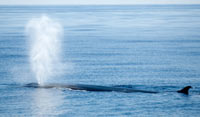 Bushy blows: The blowhole is situated very close to the front of the head and shifted to the whale's left. This gives rise to a distinctive bushy blow angled forward. The dorsal fin is set about two-thirds of the way down the spine and is typically short and shaped like an equilateral triangle. Bushy blows: The blowhole is situated very close to the front of the head and shifted to the whale's left. This gives rise to a distinctive bushy blow angled forward. The dorsal fin is set about two-thirds of the way down the spine and is typically short and shaped like an equilateral triangle.
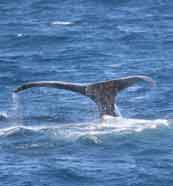
High fluke: The fluke is also triangular and very thick. Flukes are lifted very high out of the water before a whale begins a deep dive.
Toothy whale: Sperm whales have 20–26 pairs of cone-shaped teeth in their lower jaw. Each tooth can weigh as much as one kilogram. The reason for the existence of the teeth is not known with certainty.

Squid research in a whale stomach: Sperm whales, along with Bottlenose whales, are the deepest-diving mammals in the world. They are believed to be able to dive up to 3,000 meters in depth and 2 hours in duration to the ocean floor. More typical dives are around 400 meters in depth and 30–45 minutes' duration. They feed on several species, in particular giant squid, octopuses and demersal rays. Almost all that is known about deep sea squid has been learned from specimens found in captured 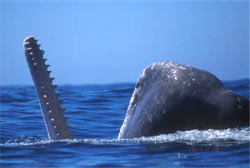 Sperm whale stomachs. Sperm whale stomachs.
Sea Battles: Stories about titanic battles between Sperm whales and giant squids which are believed to reach up to 13 m (44 ft) are perhaps the stuff of legend. However, white scars on the bodies of Sperm whales are believed tvo be caused by squid. It is also hypothesized that the sharp beak of a consumed squid lodged in the whale's intestine leads to the production of ambergris, analogous to the production of pearls. Sperm whales are prodigious feeders and eat around 3% of their body weight per day. The total annual consumption of prey by Sperm whales worldwide is estimated to be about 100 million tons — a figure comparable with the total consumption of marine animals by humans each year.
In addition, long-line fishing operations in the Gulf of Alaska have complained that numerous Sperm whales have taken advantage of their fishing operations to eat desirable species straight off the line, sparing the whales the need to hunt them themselves.
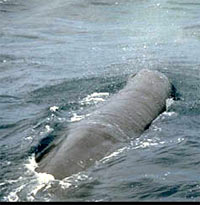
Under pressure: The physiology of the Sperm whale has several adaptations to cope with drastic changes in pressure when diving. The ribcage is flexible to allow lung collapse, and the heart rate can decrease to preserve oxygen supplies. Myoglobin stores oxygen in muscle tissue. Blood can be directed towards the brain and other essential organs only, when oxygen levels deplete. The spermaceti organ may also play a role.
Decompression shows in the bones: While Sperm whales are well adapted to diving, repeated dives to great depths do have long term effects on the whales. Skeletons of Sperm whales show pitting of the bones that is often a sign of decompression sickness in humans. Skeletons of the oldest whales showed the most extensive pitting, whereas skeletons of Sperm whale calves showed no damage. This damage may indicate that Sperm whales are susceptible to decompression sickness, and sudden surfacing could be lethal to them.
Between dives, the Sperm whale will come up to the surface for breath and remain more or less still for eight to ten minutes before diving again.

Social females, loner males: The social structure of the Sperm whales species divides on sexual lines. Females are extremely social animals, a trait believed to derive from their relatively simple evolutionary path. Females stay in groups of about a dozen individuals and their young. Males leave these "nursery schools" at somewhere between 4 and 21 years of age and join a "bachelor school" with other males of a similar age and size. As males grow older, they tend to disperse into smaller groups, and the oldest males typically live solitary lives. Yet mature males have been stranded on beaches together, suggesting a degree of co-operation not yet fully understood.

Most sexually dimporhic whale: Sperm whales are amongst the most sexually dimorphic (that is, males and females differ greatly) of all cetaceans. Males are typically 30%–50% longer (16–18 m, 52-59 ft) than females (12–14 m, 39-46 ft) and weigh about twice as much (50,000 kg vs. 25,000 kg, 55 short tons vs 27.5 short tons). At birth both males and females are about 4 m (13 feet) in length and 1,000 kg (1 tonne) in weight.
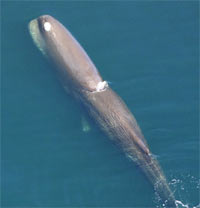
Decrease because of whaling:
Due to extensive whaling, Sperm whale size has decreased dramatically, mostly because the largest males were killed first and most intensively, for they had more spermaceti (spermaceti oil was of great value in the 18th and 19th century). In a Nantucket museum there is a jawbone of a sperm whale which is 5.5 m (18 ft). The jawbone makes up to 20%-25% of the sperm whale's overall body length. Thus this whale might have been 28 m (90 ft) long, weighing around 150 metric tons (165 short tons). Another evidence of large bulls of the past resides in New Bedford museum, a 5.2 meters (17 feet) jaw of a bull that could have been about 25.6 meters (84 feet) long, weighing about 120-130 tons. In addition, log books found in the Nantucket and Bedford museums are filled with references to bulls that were, considering the amount of oil they yielded, about the same size as these two examples. Today, Sperm whale males average 18 m (60 feet) in length and 52 metric tons (57 short tons) in weight.

The blob: In July 2003 a huge blob of white flesh was found washed up on a beach on the coast of southern Chile. The 12-metre-long (40 ft) mass of gelatinous tissue gave rise to speculation that a previously unknown giant octopus had been discovered. However, researchers at the Museum of Natural History, Santiago concluded that the mass was in fact the innards of a Sperm whale, a conclusion drawn by looking at the dermal glands. When a Sperm whale dies, its internal organs rot, until the animal 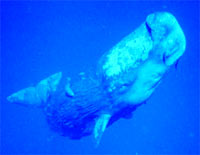 becomes little more than a semi-liquid mass trapped inside the skin. In this case, the skin will eventually burst, causing the internal mass to float free and eventually wash up on the beach. becomes little more than a semi-liquid mass trapped inside the skin. In this case, the skin will eventually burst, causing the internal mass to float free and eventually wash up on the beach.
Dead whales on the beach: Dead Sperm whales float towards shore quite often. Apart from the disposal issues identified above, beach managers fear that sharks, in particular the Great White shark, will be attracted towards the beach by the rotting flesh, and potentially cause danger to beach users. For this reason, dead Sperm whales are often towed out to sea before they become properly beached. This occurred twice in May 2004, once off Oahu in Hawaii where a dead whale was towed out 35 miles to sea but floated back to shore two days later.
All text is available under the terms
of the GNU Free Documentation License
|
